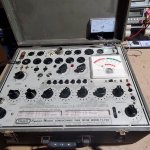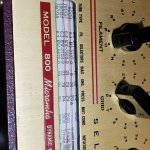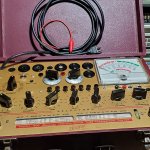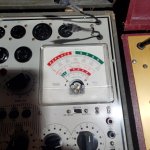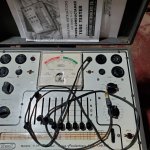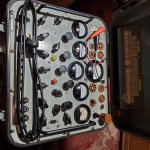Hi guys I just picked up a Starkit 12-22a tube tester and it needs a meter , does anyone know of a company that sell something that may work . (500au ) it's a real nice tube tester and would hate to scrap it for a simple meter .I tried using it with a volt meter attached to the meter outputs and it seems to be working .. thanks for any help .. cheers Roger
Last edited:
Well I have some interesting news ,the meter on my stark 12-22A was fried when the guy shattered the short switch and then likely tried to use it . Anyway after exhausting searches with no luck finding a meter . I tried a little out of the box thinking . I know the meter is 500UA so I purchased the largest faced 500UA meter I could find on Amazon it only cost around $20 so I figured what do I have to loose . I tried the new meter and it seemed to be putting the needle in the correct position . Bit useless using a meter that reads from 0-500 UA but I knew that and was hoping I could pull the movement out of the new meter and modified the old meter to take it . bit of creative work and it fit.. Works out the needle is a tad shorter but it reads perfect , line adjust comes in at the correct voltage and all the tubes are reading as they should matching the readings on my other Hickok testers . Thought this may help others with one of these old testers. $20 and a hour of my time and the old girl is working perfect ..
Last edited:
While doing some cleaning and adjusting on my Hickok 800 that always seem to read a bit low .. I noticed how much of it difference it makes when zeroing the needle , just the slightest adjustment to the zeroing makes a huge difference to the line adjustment voltage . I dropped the zeroing of my needle one needle thickness , this requires you to increase the line voltage quite a bit , in turn this results in much higher tube readings . I used a bogie tube and adjusted the needle until I got correct tube reading . Barely a needle thickness difference at zero has my tester reading bang on .. I'm sure the meter has a tired magnet but this small adjustment has it for the most part reading very normal .. Now I just use my tester for tube testing ,if you were using it for a diode or transistor leak test you may need to reset zero to more accurately use the lower end of the scale but it's such a small difference I don't think it would have much of a effect anyway.. cheers
Nice find!
I have a "new" Starkit 9-99 in the original box with all manuals. Unbuilt, but it is missing the power transformer and most electronics. Of course it looks new because it was never even completely assembled. Very nice wooden case.
I have a "new" Starkit 9-99 in the original box with all manuals. Unbuilt, but it is missing the power transformer and most electronics. Of course it looks new because it was never even completely assembled. Very nice wooden case.
Yes I was given a stark 9-99 too and of course like both my stark's they have the cases beat right off them but the meters themselves work very nicely . Have quite the collection now and learning quite a bit getting these old machines going ..Have a TV2/U , Hickok 800 , Stark 9-99 , Stark 12-22A every one had problems that needed investigation . The guy also gave me 2000 tubes that I have been going through , Even some Mullard EL37 NOS that I understand are very expensive , If I sell them I will surprise the nice elderly guy with some funds .. I tell you nothing teaches you more then putting a few hundred tubes through these old tube testers .. What I don't get is the difference in readings from the stark and the Hickok , The Hickok 800 and the Stark 12-22a seem to use close to the same roll chart setting but call for different output readings . The Hickok calls for 2600 on a 6cg7 and the stark is calling for 1250-2000 ? . I really like the way stark gives you a range for the tube but it's a little strange that they call for different reading altogether . They must use different voltages and and current across the circuits giving them different results . Really drives home the fact that these testers were comparative tools not absolute measuring devices . The jobs the tubes were doing were no more constant then the then the test procedures .. You just needed to know your tester and the application for the tube to know if it was good enough for a given purpose .cheers
I've never looked at the differences between Hickok and Stark transconductance readings. Stark are Hickok designs and licensed. It's possible the tubes are under different conditions in the Stark units. Still, you would expect the transconductance readings to be the same as in what the equivalent would be. That would be test conditions translated to what they would be if ... Giving a range of readings would be roper in a service test environment. Not ever having owned a Hickok, I can't say.
I own a few 9-66 units, a TV2/u (have to restore it) and other Heathkit, Jackson and Sencore testers. As a young tech, it was my job to test tubes. Tested many let's just say. This poor little 9-99 is missing it's innards. I'll probably make a power supply and do my own test circuits inside it.
I own a few 9-66 units, a TV2/u (have to restore it) and other Heathkit, Jackson and Sencore testers. As a young tech, it was my job to test tubes. Tested many let's just say. This poor little 9-99 is missing it's innards. I'll probably make a power supply and do my own test circuits inside it.
Yes but from my understanding so far transconductance is a result of a inputs . Not a absolute or static measurement.. The only difference in the thumb wheel setting on the two testers is the Go No Go tube setting(good bad setting ). The transconductance settings are exactly the same . The testers must be testing the tubes under different conditions . Quite happy with my meter on the 12-22A wish I could think of a way to lengthen the needle a bit ..You can see the 2 little holes that mounted the face plate on the old meter , the new meter had a different pattern so had to drill new ones but I think it still looks better having it's factory face plate .
Attachments
Last edited:
Very nice condition, all of them.
Yes, I know the input signal for Hickok uses an oscillator, the Stark is a power supply derived one. It drives the tube under test into clipping. They probably experimented with some bogey tubes to arrive at the transconductance figures. The transconductance may vary with input signal and supply voltages / currents. My understanding is that it's more where you measure it on the curve. I could easily be wrong, I haven't studied it very much.
Your meter looks fine You don't really need a longer pointer. I'd be pretty happy with that! You did a very nice job.
Yes, I know the input signal for Hickok uses an oscillator, the Stark is a power supply derived one. It drives the tube under test into clipping. They probably experimented with some bogey tubes to arrive at the transconductance figures. The transconductance may vary with input signal and supply voltages / currents. My understanding is that it's more where you measure it on the curve. I could easily be wrong, I haven't studied it very much.
Your meter looks fine You don't really need a longer pointer. I'd be pretty happy with that! You did a very nice job.
I agree I think that is exactly what's going on , both testers use a 5y3gt /83 combo but the stark looks far better quality inside , but then again it's Canadian LOL ..The best part is my meter is back to working for $20 , I was looking at one of those factory meters from a company in the states but it would have been $500 Canadian , just could not justify it .. But it's such a nice tester I could not bring myself to trash it without at least trying . Have to say now that it's working it's my favorite tester so far , I don't even know what half the features do on this tester they went so over the top with it .. Will have to sit down with the manual now that it works and figure it out .. I tell ya fixing that broken short switch was a real challenge , unless your very careful removing the meter you can catch the switch on the box (I'm sure that's what some guy did to this one then plugged it in a fried the meter ) , I have see a few guys looking for this switch for what I am sure is careless removal .So anyone with one of these please be careful removing the meter , you must lift it out from the left side for the switch to clear .When attempting the switch repair I could put the parts of the switch back together but had no idea how the center contact went back in , just by sheer luck the first picture I find on the 12-22 is a picture of the back of the short switch, Like some sort of miracle , it was still a real job putting all those broken parts back together and fixing many of the mangled contacts . My years of R/C plane modeling helped with the fine work.. Now to look for another challenge ..
Last edited:
Well, I am impressed. I've seen many broken wafer switches and the contacts are the tough part. I am not normally not successful with the contacts.
Lots of pictures , this wafer was badly damaged too 8 pieces .. I used CA to put the parts back together and made a mica ring to back it up for support , once glued in place it's stronger then factory , if I ever find one I will replace the wafer but if not it works the way it is ..I could always make one from scratch from PC board on the rotary table . I have the micro screws to reassemble the contacts , you need to remove the contacts to repair them ..
Last edited:
Just read through the manual and it does not reveal what the 2 leads with small clips do above the meter ?? anyone have any ideas . it has other outputs for grid & plate , another set for checking diodes but nothing on these strange little leads ?? bit of a puzzle ,none of my other testers have them ..
With the instrument off and unplugged, check continuity to other socket pins. They may be for checking diodes with flying leads. Finding out where they go may be all the help you needed.
I don't have this model, so I can't say.
I don't have this model, so I can't say.
Will check that out , this tester is like the Swiss army knife of testers LOL. 23 sockets and multiple outputs for various tests ...
Last edited:
It looks pretty cool.
Maybe some day I'll end up with one and I'll check it out. For now, the 9-66 is proven performer. The 12-22 handles new tubes without me having to make adapter sockets.
Maybe some day I'll end up with one and I'll check it out. For now, the 9-66 is proven performer. The 12-22 handles new tubes without me having to make adapter sockets.
Finding additional tube information is the shortcoming of the 12-22a , it's quite rare making information scarce .. It has quite a comprehensive thumb chart but I have already noticed tubes missing . I guess I could use the Hickok tube charts and drop the expected reading by 20% ..
If that's the ratio, it should apply across the board. I haven't had to look for anything on the 12-22.
Anyone have or know where I can find a #49 and the #81 bulbs that these tube tester use , My 12-22A had the wrong bulbs in it . I used the ones from my Hickok but now that I know it's working fine I would like to find a set . maybe even a couple of sets so I can have some spares .. thanks for any help . I did try Mouser and Digikey but they are getting crazy with the shipping and want $35 us to ship .
- Home
- Design & Build
- Equipment & Tools
- Starkit 12-22A needs Meter

